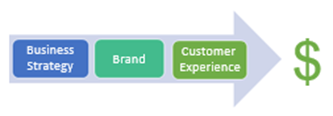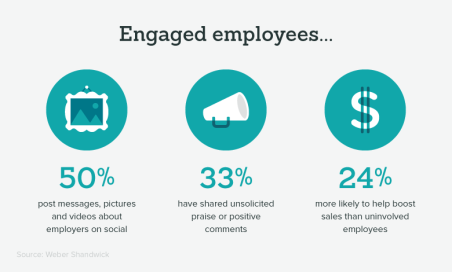Driving Customer Loyalty with Employee Commitment
Three Empowering Steps to Sustained Sales Growth
My blog posts have generally emphasized the importance of aligning the business
strategy with the brand and culture to deliver authentic customer engagements:

To create a memorable customer experience, leaders must first be convinced of how employees drive the customer experience/engagement (Step 1). The organization’s leadership must then work to hire and develop truly engaged employees (Step 2) through leadership that minimizes employee turnover (Step 3), maximizing stability for sustained growth.
Building Sales with Connected and Committed Employees
Intuitively, we believe engaged employees create the level of customer engagement that drives customer loyalty. But as my favorite fortune cookie said, “Never ignore a gut feeling, but never believe it’s enough.”
It helps to know that TDn2K’s recent June data shows how restaurants with a 14.8% service score increase delivered a plus 18.8% intent to return increase (a pattern consistent with other time periods). Or that the top 25% of full-service restaurants delivered 10.5% sales growth with a 9.0-point higher service score than the lowest 25% of their competitors.
Other sources, such as Prosell Learning, report that engaged employees create 23% sales growth while the control group managed 15%. Research—not surprisingly― demonstrates engaged employees are characterized by providing 57% more discretionary effort and are less interested (87%) in leaving the company (we will see later how low employee turnover is also a primary sales driver). And for financial rewards are generally less important to these engaged staffers.
 Other surveys in various industries demonstrate how top performing quartiles are characterized by customer service leadership or fuller customer engagement. In short, consistent customer engagement is generally the biggest differentiator driving a customer’s intent to return or buy.
Other surveys in various industries demonstrate how top performing quartiles are characterized by customer service leadership or fuller customer engagement. In short, consistent customer engagement is generally the biggest differentiator driving a customer’s intent to return or buy.
But roughly one in three organizations have not defined the core values and actions needed to develop meaningful customer relationships (“Customer Experience Value Chain: Paving the Way to Advocacy”).
Dynamics of Creating Empowered Sales Drivers
But how do you provide your customers with employees who are fully engaged, whether they are answering customer service calls, helping a customer find the right outfit, or serving a table of guests at a restaurant (or drive-thru)? There appear to be two keys, and they probably relate to each other.
Following a Boston Consulting Group analysis, engaged employees are employees who work for each other. Their desire to create and perform in an effective organization is nurtured and cultivated, and they see their own success as contributing to the team’s success.
The goal, then, is for the organization to focus on the group’s success, and the  individuals’ cooperating and supporting each other must be rewarded. Delivering team success is hard work, and the leadership must stimulate mutual interest in this success. Having a collective culture that points to a higher calling—beyond sales―can take the motivation away from individual successes to a “greater good.” An example might be to go beyond the more typical functionally focused sales goals to creating better neighborhoods and communities (as they relate to retail store locations). The point is to provide a “greater good” that goes beyond the individual’s specific task and connects each employee for more teamwork.
individuals’ cooperating and supporting each other must be rewarded. Delivering team success is hard work, and the leadership must stimulate mutual interest in this success. Having a collective culture that points to a higher calling—beyond sales―can take the motivation away from individual successes to a “greater good.” An example might be to go beyond the more typical functionally focused sales goals to creating better neighborhoods and communities (as they relate to retail store locations). The point is to provide a “greater good” that goes beyond the individual’s specific task and connects each employee for more teamwork.
The organization’s leadership must create reward and recognition systems which shed light on not just the top performers but also the importance of each role’s contributing to the whole. I am reminded of a CEO of mine who used “Russian nesting dolls” to demonstrate how the largest contributor could only be there with the support of the smallest. In the restaurant business, the back-of-the-house dishwasher is as important as the manager and server. Have you ever gone back to a restaurant using less than dishes?
The mutual needs of every employee and his or her function must be made visible to and celebrated by all so that everyone can work for each other’s success. And this direction is completely consistent with today’s need for a responsive workforce free to actively problem solve.
More Effective and Committed Employees
In a world where it is generally recognized that most employees are not feeling engaged in their work (according to historical Gallup polls, only 32% feel engaged), it is easy to understand how relatively high staff and management turnover is much more significant in the lowest performing organizations.
High turnover rates, especially at the management level, impact organizational stability and lead to increased costs, lower morale and inconsistent performances while reducing the effectiveness of customer-centric training and management leadership (“Link Between Employee Engagement and Turnover Rate”). It takes time to not only learn but also get hooked by a customer and employee focused culture.
 Creating an engaged employee force focused on the customers requires the creation of an environment where growth and development are encouraged, opinions valued, and recognition and praise for teamwork ingrained in the culture.
Creating an engaged employee force focused on the customers requires the creation of an environment where growth and development are encouraged, opinions valued, and recognition and praise for teamwork ingrained in the culture.
Leading factors blocking the engagement levels we all seek—beyond those broader strokes described above―are a poor relationship with “the boss,” a lack of challenges and opportunities, and a lack of belief in the company mission.
Countering the negative effects of employee turnover is another benefit of engaged employee teams. The impact of less than engaged employees (“When Numbers Fall …”) includes:
- Increased costs―Typically over 20% of the departed person’s salary to find the replacement.
- Loss of experience―New employees need time to learn the company’s values and expectations and relevant roles of others.
- Declining productivity―The less than fully developed and experienced staff requires development and training, time to settle into the new job for it to be more “intuitive.”
- Reduced profits―Potential litigation, settlements, and the like impact the bottom line as well as morale.
As Richard Branson is reported to have said, “… train people well enough so they can leave, treat them well enough so they don’t want to.”
Suggested Related Articles
Secret to CX Success: The Customer Experience Value Chain
How Great Managers Motivate Employees
Leading in Emotional Times
Employee Engagement Leads to Customer Loyalty
Nail These Four Customer Service Moments and Watch Customer Engagement
and Loyalty Soar